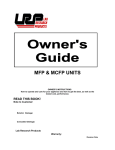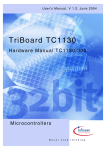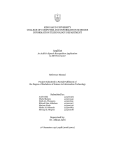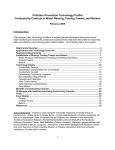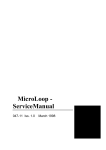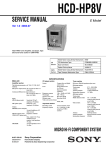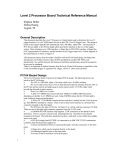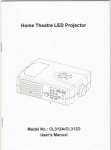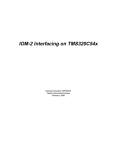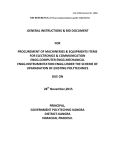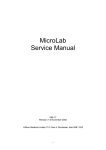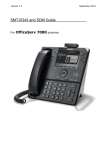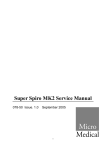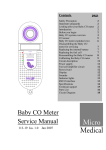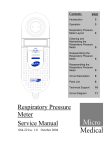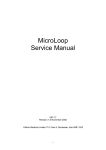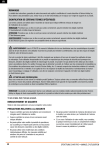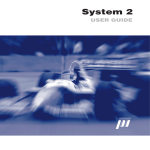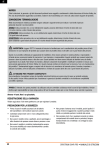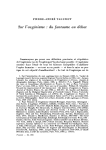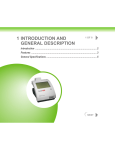Download Super Spiro - Service Manual
Transcript
Super Spiro - Service Manual 056-09 Issue. 1.0 November 1999 Contents Exploded isometric view Parts list System overview Transducer Disassembly instructions Re-assembly instructions Circuit description Microprocessor circuit Flash disk Serial interface Transducer interface Frame store FPGA Keypad circuit Real time clock circuit Sound generator circuit Printer control circuit Expansion Printer driver circuit Technical support Fault analysis Circuit diagrams Micro processor circuit FPGA circuit Keypad circuit Real time clock circuit Printer circuit Printer driver 1 Printer driver 2 Page 3 Page 4 Page 5 Page 6 Page 7 Page 8 Page 9 Page 9 Page 10 Page 10 Page 10 Page 10 Page 11 Page 11 Page 12 Page 12 Page 12 Page 12 Page 12 Page 13 Page 14 Page 15 Page 16 Page 17 Page 18 Page 19 Page 20 Page 21 2 Exploded Isometric View Item 8 Item 10 Item 15 Item 20 Item 1 Item 16 Item 21 Item 7 Item 4 Item 9 Item 18 Item 6 Item 17 Item 12 Item 14 Item 22 Item 9 Item 13 Item 11 Item 2 Item 23 Item 5 Item 3 Item 19 3 Parts List ITEM No. 1 2 3 4 5 6 7 8 9 10 11 12 13 14 15 16 17 18 19 20 21 22 23 DESCRIPTION TOP MOULDING BACK PANEL SIDE PANEL DISPLAY CABLE ASSEMBLY BOTTOM MOULDING HINGE BLOCK DISPLAY FRONT DISPLAY BACK DISPLAY HINGE ASSEMBLY PAPER COVER CSK SELF TAPPING SCREW 9mm LONG SPEAKER SPEAKER COVER CONTRAST WHEEL SCREW COVER CSK SELF TAPPING SCREW 8mm LONG CSK SELF TAPPING SCREW 13mm LONG M3 MACHINE SCREW 6mm LONG CSK SELF TAPPING SCREW 18mm LONG DISPLAY LATCH DISPLAY LATCH BUTTON PRINTER MECHANISM THERMAL PRINT HEAD 4 MICRO MEDICAL PT No. MLD5611A MLD5615C MLD5615B ASS5624 MLD5612A MLD5618 MLD5613 MLD5614 ASS5601 MLD5617 SCR5604 SPKR100 MLD5620 MLD5621 MLD5616 SCR5602 SCR5601 SCR0306 SCR4700 MLD5619 MLD5622 PTR4200 TPH3000 Super Spiro - System Overview (Fig. 1) The Micro Medical Super Spiro is a data recording spirometer consisting of a microcomputer unit (1) incorporating a 1/4VGA colour LCD display, data entry keypad, RS232 serial interface and all associated circuitry. It is supplied with a digital volume transducer (2), disposable mouthpieces, transducer holder (3) and mains adapter (4). The Super Spiro is powered by a universal mains adapter (4). When testing a subject the transducer is inserted into the holder which is plugged into the microcomputer unit. The digital volume transducer is used to measure the subjects expired flow and volume in accordance with the operating manual. 1 su p e r spiro 4 Micro Medical 3 2 5 Transducer (Fig. 2) The Micro Medical digital volume transducer consists of an acrylic tube with a vane positioned between two swirl plates. The low inertia vane is attached to a stainless steel pivot, which is free to rotate on two jewelled bearings mounted at the centre of the swirl plates. As air is passed through the transducer the swirl plates create a vortex, which causes the vane to rotate in a direction dependant upon the direction of airflow. The number of rotations is proportional to the volume of air passed through the transducer and the frequency of rotation is proportional to the flow rate. The transducer housing consists of a main body that contains a pair of light emitting diodes (LED’s) and phototransistors. The transducer is fixed to the mouthpiece holder which pushes into the main body and is captured by an “O” ring seal. The LED’s produce infra red beams which are interrupted by the vane twice per revolution. This interruption is sensed by the phototransistors. The output from the collector of each phototransistor will be a square wave with a phase difference between the two of + or - 90 degrees depending upon the direction of flow. There is no routine maintenance required for the transducer other than cleaning according to the instructions in the operating manual. Micro Medical Digital Volume Transducer Rotating vane Infra red emitter Swirl plate Jewelled bearing Infra red detector Volume = k X No. of pulses Volume proportional to the number of pulses Flow proportional to the puse frequency Flow = k / pulse period 6 Disassembling the Super Spiro for Repairs Main Unit 1. Disconnect all mains power supplies 2. Remove paper roll and paper roll housing cover, and put to one side We recommend that you use a Philip Number Zero screwdriver for the following instruction. 3. Place the Super Spiro face down to remove the six screws (Item 19) in the lower moulding, and put the screws to one side. 4. Turn the unit face up before easing the upper and lower mouldings apart. 5. Reconnect mains power supply 6. The Super Spiro is now ready for fault finding. Display Console 1. Remove the 4 screw covers (item 15) and dispose of. We recommend that you use a Philip Number Zero screwdriver for the following instruction. 2. 3. 4. 5. 6. Remove the 4 screws (item 16) and put to one side. Carefully remove the display front panel (item 7) and put to one side. Carefully pull the display away from the display back moulding (item 8). Unplug the 2 connectors from the main display. The display backlight is now ready for replacement. Display backlight replacement DISPLAY (REAR VIEW) CFL CONNECTOR INVERTOR BOARD CFL UNIT FIXING SCREW KCS3224A CFL UNIT 1. Place the display face down on a clean work surface 7 2. Unplug the connector from the Invertor board situated on the back of the display. We recommend that you use a Philip Number Zero screwdriver for the following instruction. 3. Loosen the fixing screw located on the CFL unit. 4. Slide the CFL unit to the opposite direction to the arrow mark (located on the CFL unit) and pull the unit gently up. 5. Safely dispose of the CFL unit. 6. Take a new CFL unit and position in the original place. 7. Slide the CFL unit in the direction of the arrow. 8. Tighten the fixing screw to secure the CFL unit. 9. Reconnect the connector on the CFL unit to the invertor board. Reassembling the Superspiro after repairs Main unit 1. Disconnect all mains power supplies 2. Position the top moulding over the bottom moulding and ensure that they both mate ensuring that the contrast wheel (item 14) is correctly located. 3. Place the Super Spiro face down and insert the six screws. 4. Turn the unit face up and connect the mains supply. 5. Turn the unit and offer up the paper roll as explained in the operating manual. 6. Replace the paper cover. 7. The Super Spiro is now ready for operation. Display console 1. 2. 3. 4. 5. Reconnect the 2 connectors on item 4 to the plugs on the display ensuring correct polarity. Position the display over the locating pillars on the display back panel (item 8). Position the display front panel (item 7) over the display. Secure the display using 4 screws (item 16) Replace the 4 screw covers (item 15). 8 Circuit Description The Super Spiro board was designed primarily to interface with the Micro Medical Spirometer turbine, but the interface was kept open ended so that other modules, for example, airways resistance by the interrupter method (Rint) can be attached. Furthermore, a 9 pin ‘D’ type connector was also designed in to allow other ‘customer special’ modules to be attached. Provision was given to add a mezzanine board for customer special interface circuitry to be connected. The main features of the design are: Intel 80386EX micro controller. 2 Mbytes of DRAM (only 1 Meg is used). 512 Mbytes of Flash EPROM for programme. (256K used) 2 Mbytes of Flash EPROM as Flash disk memory. Dual frame store of 320 X 240 X 8 pixels. Second frame store can be scrolled horizontally or vertically. Frame store, key pad, Dram etc. are all controlled by single FPGA chip. Boot software can be downloaded using the JTAG port. In built printer and printer controller. Serial port for external PC communication / external printer. RJ11 interface to Micro Medical modules. The following paragraphs describe the circuits printed at the end of this manual. Signal and component names shown on the circuit diagrams are printed in bold type. Microprocessor circuit (Drawing 056-02) The board is controlled by an Intel 80386EX, U14, running at 25 MHz. The crystal oscillator, U15, of 50MHz drives the processor, as twice the operating frequency is required. U10 (MAX 824) controls the reset of the processor, such that it resets the processor if the supply voltage drops below 4.6V. The processor requires a high active reset line whilst the rest of the board requires a low active reset. The start up program is stored in U20, a 512 Mbytes Flash EEPROM – TE28F160S. This is selected by the signal UCS (U14 pin 1) which is always active on start up. The reset of the chip select lines are then programmed by the boot routine. The program memory has two major parts, the boot section and non-boot section. The boot section is secured, and can only be programmed if the link LK1 is present and VPPEN (U14 pin 110) is enabled, supplying VCC to pin 13 of U19. This section is programmed with a boot loader via the onboard socket, J9. Whilst this is happening the processor goes into suspend mode, and all its pins are then available in a long shift register. By entering a correct sequence of code, via J9, the boot loader can be programmed into U19. Once this is done, the link is removed and processor is reset and it would then run the boot loader, thus allowing further software to be downloaded. The rest of U19 is filled with kernel software that controls the flash disk as well as most I/O functions, just as the BIOS does in the PC. U18 is 1M X 16 (2 Mbytes) DRAM which is the main RAM of the processor. Only 640 K is directly available to the processor, and 128 K is used for storing the display image temporarily (see later). The DRAM refresh and address multiplexing is controlled by U13 – Xilinx XC4006E FPGA. The chip select for the DRAM, UC3, is mapped for 0 - $BFFFF, but $A0000 - $BFFFF is frame store memory, so UC3 is only valid if frame store is invalid. This will become clearer in the Frame Store section. Q23, Q24 and U22A are used to switch on 5 volts to VPP of Flash EEPROM. This gives extra security against any part of the program becoming corrupted by software. However, the software can write the non-boot section, by enabling the VPP line and following the EEPOM erase/write algorithm. Chances of both these events accidentally happening are very small. Nevertheless, the boot software is completely protected by the absence of Link LK1. 9 Flash Disk (Drawing 056-02) The flash disk, U20, behaves just like a PC floppy disk drive except that it is non-removable. Its size is 2 Mbytes with sector size of 512 bytes. The main difference is that there is a finite number (approximately 100,000) of times the sectors can be written, so an intelligent disk operating system is employed to rotate the sectors round, and delete the others when no system activity is envisaged. Delete takes few milliseconds. The Flash Disk is mapped at $C8000 - $CBFFF (16K blocks). There are 128 pages of 16K, and the pages are controlled by 8 bit latch U17, which holds the page number (higher addresses) of the Flash disk. The board is designed to accommodate a larger 4 Mbytes device with 256 pages. The MSB of the page line (U17/19) is connected to green led. This is mainly used for testing of the board and has no other significance. Serial Interface (Drawing 056-02) U4 (MAX3223) converts logic levels to RS232 levels. J3, a 9-pin female D type connector, is used as the external RS232 port. The signal pins are such that it can make one to one connection with the PC serial port. It has the facility to use hardware handshaking lines CTS and RTS, but these are currently not used. If power supply is required from the RS232 connection, say to drive a serial to parallel converter, then fuse FS2 can be fitted to give 5V on pin 4 J3 pin connections. 1 2 3 4 5 6 7 8 9 N/C TX RX 5V* GND N/C CTS RTS N/C * If fuse connected. Transducer Interface (Drawing 056-02) The connector, J13, is used for connecting to Micro Medical transducers, namely Spirometer turbine, Rint and NEP transducers. It is a 6-pin interface, though for turbine, the middle 4 lines are used. 12V power is available on pin 5 and GND on pin 4. The rest of pins are multifunction, and can be configured in various ways, either as inputs, outputs or SPI bus. Pins 2 and 3 have schmitt trigger inputs connected to it, mainly for turbine operation. Frame Store (Drawing 056-03) Frame Stores are mapped from address $A0000 to $BFFFF (128 Kbytes). Although, the actual display is 320 X 240 pixels, the frame store is organised as 512 X 256 pixels. This organisation makes the design much simpler. The frame store memory U11 and U12 are both high speed static RAM, U11 being a fixed frame store (A) and U12 a scrolling frame store (B). They overlay on top of each other and their mode can be controlled by I/O register in the FPGA, U13. It can be organised as A on B, B on A, A only or B only. A on B means that where the A data is 0, B data is displayed. This allows a border to be displayed on fixed screen, and a waveform scrolled inside the window. During read, both the memories are multiplexed, so that its data can be read in one cycle. The display requires data as 8 bits, with r1, g1, b1, r2, g2, b2, r3, g3 as the first byte, b3, r4, g4, b4, r5, b5, g5, r5 as the second byte and so on. The data from frame store is available as pixel 1, pixel 2 etc. with each pixel being 8 bits. The FPGA has the necessary look up table to display 64 colours (bits 0 – 10 bits 5) and converts pixel data to RGB data as required by LCD. This is a complex operation and is beyond the scope of this document. It is sufficient to know that the RGB data is sent out to LCD via J11. DISP_FRAME signal is a single line, active low pulse at the start of every frame. DISP_LOAD is a single, active low, clock pulse at the start of every line. DISP_CLK clocks the data DISP_D0 – DISP_D7 into the display. DISP_CNTL enables the display. U25 is a DC to DC converter to give 26.4 volts from 5V supply. This is the bias voltage for the LCD display. It can be slightly adjusted by VR1 to give better contrast at different viewing angles. J10 is a back light connector that provides power to the back light. Q22 is used to enable the back light. It was designed for power saving, but since the unit only operates on mains, this feature is not currently used. VR3 controls the back light intensity in some back light modules, but this feature is not in the modules currently fitted. The frame store data can be saved quickly in the RAM that resides in the same address space, using a block transfer. This is done by first programming the CS3 line to address space $A0000 - $AFFFF. Since $B0000 - $BFFFF is now not the part of CS3, the FPGA will map it to DRAM. The whole 64K page can be transferred from $A0000 (frame store) to $B0000 (RAM). The CS3 line is then programmed for $B0000 - $BFFFF allowing $B0000 (frame store) page to be transferred to $A0000 (RAM) page. CS3 is then restored back to $A0000 - $BFFFF. Restoring the screen is inverse of the above procedure. FPGA (Drawing 056-03) This device controls most of the circuitry not controlled by the processor. The program for the FPGA resides in serial EEPROM, U8, and is downloaded once on power up. The processor monitors the FPGADONE line to ensure that FPGA is programmed before commencing, otherwise, the DRAM will not be operational. Besides DRAM, the FPGA controls the LCD display, keypad, sound chip, and most of chip select lines. These CS lines can be programmed in the processor, but this can be further qualified in the FPGA if necessary. There are some spare serial enable lines for an additional 9 pin I/O port and the mezzanine expansion board. Keypad Circuit (Drawing 056-04) The keypad consists of a matrix of 25 keys together with a separate paper feed key and on/off key. The matrix is read by successively pulling the columns of the matrix low, KEYOUT[0..4], and reading the state of the rows, KEYIN[0..4], to determine which key has been pressed. KEYOUT[0..4] and KEYIN[0..4] are connected directly to the FPGA (see 056-03). The diodes, D7and D8, prevent current flowing between the lines of KEYOUT[0..4] in the event of two keys on the same row being depressed simultaneously. The resistor network, RN5, bias KEYIN[0..4] to VCC. The on/off switch is used to apply the 5V from the external power supply to the circuit, VCC, and turning the unit on. When the on/off key is depressed, the pull up resistor, R3, is pulled to ground. R3, C17 and the schmitt input gate U3A form a de-bounce circuit whose output is applied to the clock input of a bi-stable latch, U2B, that is powered directly from 5V and is active all the time the power supply is plugged in. The output of the latch is applied to Q19 that in turn switches the series pass transistor, Q20, to connect 5V to VCC. The latch, U2B, is also controlled by the set and reset inputs. By taking the set input to 5V the unit will be turned on and by taking the reset input to 5V the unit will be turned off regardless of the clock input. The set input is asserted by either the real time clock alarm output, RTC_INT (see 056-05), or by the POWER_ON signal from the processor (see 056-02). The reset input is asserted or by the POWER_OFF signal from the processor. 11 Real Time Clock Circuit (Drawing 056-05) The real time clock, U16, is set by the processor during the factory set-up and may be adjusted using the configuration module. The processor communicates with the real time clock through a bidirectional serial interface line, RCA_DATA, is clocked by RTS_CLK, and is selected by RTC_SEL. The processor (see 056-02) generates these three control lines. Sound Generator Circuit (Drawing 056-05) The various sounds used in the spirometry tests are generated by U7 and associated components. This device contains the addressable, pre-programmed sounds and is controlled by the lines, SNDCNT[0..5], generated by the FPGA (see 056-03). Printer Control Circuit (Drawing 056-06) The printer driver uses a single chip micro-controller, U6, with on board program memory and RAM to receive serial data from the microprocessor, U14, and control the printer mechanism. The asynchronous serial lines PRNTDATA and PRNTACK are used by U14 to send and receive data to and from U6. The signal BUSY generated by U6 is used to control the flow of data from U14 and PF is generated by the paper feed key. The printer mechanism uses stepper motors to drive the print head and paper feed. Each stepper motor uses four lines, driven sequentially. The order in which the lines are driven determines the direction of rotation. The thermal print head uses eight heater elements. The stepper motors and print head signals are generated on port A and B (active high) of U6. Timing for Port A and B is derived from an adjustable oscillator comprising of U9 and associated components. Adjusting VR2 varies the oscillator frequency and consequently the period for which the thermal elements are energised. This in turn adjusts the print density. After the micro-controller is first reset, the print head is driven to the left until the end switch is activated. The end switch consists of a normally closed pair of contacts accessed at pins 1 and 2 of the printer connector J2. The end switch is detected by PD5 on the micro-controller. Expansion (Drawing 056-05) J8 and J12 are 10-pin header connectors that allow a mezzanine card to be fitted. This is used for future customer special circuitry. Similarly, J14 is placed near the output plate on the right side of the unit to allow customer special signals to be connected to the mezzanine board or to the processor directly. Printer Driver Circuits (Drawings 056-07 and 056-08) The outputs from port A and B of U6 drives the two stepper motors and eight thermal elements through the high current transistors Q1 to Q16 in common emitter configuration. Diodes D1 to D4 are used to dissipate the inductive fly-back from the stepper motors and elements. Power Supply An external, dual voltage, supply provides 5.5 volts and 12 volts to socket J1 (Drawing 056-05). This power supply has a universal input, is factory sealed, and contains no user serviceable parts. 12 Technical Support Great Britain and World Headquarters Micro Medical Ltd PO Box 6 Rochester Kent ME1 2AZ Telephone + 44 (0)1634 360044 Fax +44 (0)1634 360055 Web Site http://www.micromedical.com.uk Email [email protected] Contact Micro Medical Ltd for the local agent in your region or country for local service: 13 Fault Analysis The following analysis is only a guideline and should be carried out in a logical sequence. If the fault is still apparent after the following suggestions then the unit should be fault found using the circuit descriptions and circuit diagrams provided. When the unit is turned on there is no display present -Ensure charger is turned on at the mains. FVC readings are low -Remove turbine from transducer housing. Taking the turbine, move it slowly through the air and check that the vane is not sticking. The unit does not record any blows -Inspect transducer housing connector for damage. -Check that transducer housing lead is properly connected to the RJ11 socket. -Remove turbine from transducer housing. Taking the turbine, move it slowly through the air and check that the vane is not sticking. -Blow into transducer housing and move transducer head cable around to check for breaks in the cable. 14 UADS UWR URD VCC VCC U10 5 VCC 4 C41 0.1UF 3 RES RESET- R33 10K VCC D[0..15] WDI 2 GND 1 RES D[0..15] A[1..21] A[1..21] MAX824_EUKM VCC U14 GND 1 EN UREADY 50MHz TP1 VCC TX N 98 79 RX TP2 U4 J3 16 9 1 6 2 7 3 8 4 9 5 R1 IN R2 IN RS232 T1 OUT T2 OUT 17 8 1 C26 0.1UF R1 OUT R2 OUT TTL T1 IN T2 IN EN 14 DB9 VPPEN 2 4 3 INVALID FON FOFF C1+ C1 V+ C2+ C2 V- 15 10 13 12 11 20 CS0 C24 0.1UF UCS1 UCS2 UCS3 5 6 7 MAX3223CAP C25 0.1UF 12V VCC C23 0.1UF TP21 TURB1 U22B R49 3K3 R48 3K3 3 ONLINE PRNBUSY 4 SN74HC14 SND_EOM RTC_INT- J13 U22C 1 2 3 4 5 6 5 6 C72 1nF TURB2 128 122 127 139 123 UCS5 INT1 INT2 DRQ1/RXD1 DACK1#/TXD1 DRQ0/DCD1# DACK0#/CS5# EOP#/CTS1# 106 84 86 85 STXCLK SSIOTX SSIORX R20 PRNTACK PRNTDATA 1 2 3 4 5 6 7 8 9 10 VCC J7 1 2 3 4 MOLEX 4PIN DSR1#/STXCLK DTR1#/SRXCLK RTS1#/SSIOTX RI1#/SSIORX 82 27 28 129 107 J9 0R D0 D1 D2 D3 D4 D5 D6 D7 D8 D9 D10 D11 D12 D13 D14 D15 BUSY#/TMRGATE2 PEREQ/TMRCLK2 ERROR#/TMROUT2 SN74HC14 1nF RJ11 INT4/TMRCLK0 INT5/TMRGATE0 INT6/TMRCLK1 INT7/TMRGATE1 100 96 99 TP25 C71 P3.0/TMROUT0 P3.1/TMROUT1 P3.2/INT0 P3.3/INT1 P3.4/INT2 P3.5/INT3 P3.6/PWRDOWN P3.7/COMCLK 101 102 103 104 0R R8 P2.0/CS0# P2.1/CS1# P2.2/CS2# P2.3/CS3# P2.4/CS4# P2.5/RXD0 P2.6/TXD0 P2.7/CTS0# 80 81 87 89 91 92 93 94 VCC A1 A2 A3 A4 A5 A6 A7 A8 A9 A10 A11 A12 A13 A14 A15 A16 A17 A18 A19 A20 A21 A22 A23 A24 A25 SMIACT BHE BLE P1.0/DCD0# P1.1/RTS0# P1.2/DTR0# P1.3/DSR0# P1.4/RI0# P1.5/LOCK# P1.6/HOLD P1.7/HLDA 133 134 135 136 137 140 142 143 CS4 ADS W/R D/C M/IO RD WR LBA NMI SMI# 110 111 113 114 115 116 117 121 PWR_OFFPWR_ONRTC_SELRTC_CLK RTC_DATA FPGADONE U20 RESET CLK2 NA# BS8# READY TCK TDI TMS TRST# FLT# UCS CS6#/REFRESH# WDTOUT TDO CLKOUT 43 32 31 29 37 38 4 A1 A2 A3 A4 A5 A6 A7 A8 A9 A10 A11 A12 A13 A14 A15 A16 A17 A18 A19 A20 A21 45 46 48 49 52 53 54 55 56 57 58 59 61 62 63 64 66 67 68 70 71 73 74 76 78 130 42 40 5 6 7 8 10 12 13 14 15 17 19 20 21 22 23 25 TP11 CS0 A1 A2 A3 A4 A5 A6 A7 A8 A9 A10 A11 A12 A13 FA14 FA15 FA16 FA17 FA18 FA19 FA20 FA21 CS0 32 28 27 26 25 24 23 22 20 19 18 17 13 12 11 10 8 7 6 5 4 3 A0 A1 A2 A3 A4 A5 A6 A7 A8 A9 A10 A11 A12 A13 A14 A15 A16 A17 A18 A19 A20 A21 14 2 54 55 15 CE0 CE1 OE WE VPP VCC D0 D1 D2 D3 D4 D5 D6 D7 D8 D9 D10 D11 D12 D13 D14 D15 33 35 38 40 44 46 49 51 D0 D1 D2 D3 D4 D5 D6 D7 34 36 39 41 45 47 50 52 D8 D9 D10 D11 D12 D13 D14 D15 U19 A1 A2 A3 A4 A5 A6 A7 A8 A9 A10 A11 A12 A13 A14 A15 A16 A17 A18 A19 VCC BYTE STS RP WP NC NC 31 53 16 56 25 24 23 22 21 20 19 18 8 7 6 5 4 3 2 1 48 17 16 UCS 26 28 11 13 RESET- 29 30 A0 A1 A2 A3 A4 A5 A6 A7 A8 A9 A10 A11 A12 A13 A14 A15 A16 A17 A18 D0 D1 D2 D3 D4 D5 D6 D7 D8 D9 D10 D11 D12 D13 D14 D15 D0 D1 D2 D3 D4 D5 D6 D7 30 32 34 36 39 41 43 45 D8 D9 D10 D11 D12 D13 D14 D15 VCC 47 BYTE CE OE WE VPP 29 31 33 35 38 40 42 44 LK1 12 14 RP WP 1 2 LINK2 L i 28F400B5T80 R37 10K TE28F320J5100 URD UWR UCS0 UBHE UBLE D0 D1 D2 D3 D4 D5 D6 D7 D8 D9 D10 D11 D12 D13 D14 D15 TP15 CS4 U22D LED1 9 8 1 TP20 UCS CS4 1 11 D0 D1 D2 D3 D4 D5 D6 D7 3 4 7 8 13 14 17 18 VCC 3 U17 R52 2 GREEN G CLK 1Q 2Q 3Q 4Q 5Q 6Q 7Q 8Q 1D 2D 3D 4D 5D 6D 7D 8D 2 5 6 9 12 15 16 19 FA14 FA15 FA16 FA17 FA18 FA19 FA20 FA21 470R SN74HC14 VCC UUCS 2 2 119 125 44 35 34 3 CLK TP16 VPP_EN R36 Q23 FMMT549 1 100R 74FCT377 1 2 124 1 REFRESH R50 112 VPPEN R29 VCC FA80386EX25L Q24 VCC 26 1 C63 2 R35 10K CLK25MHZ 33R DTC114EKA U22A 100K 3 FS2 300mA C51 1UF VCC 3 10R 4 2 U15 R30 0.1UF C62 1UF SN74HC14 VCC VCC 5V TP4 GND HEADER 5X2 TP28 GND TP3 GND TP24 GND VCC R53 470R S D9 5.6V VCC C4 0.1UF R54 10K 3 10 C47 0.1UF C45 0.1UF C66 0.1UF C74 0.1UF C58 0.1UF C21 0.1UF C52 0.1UF C61 0.1UF C50 0.1UF C60 0.1UF LED2 GREEN RED B C46 0.1UF 11 2 470R SN74HC14 U22E LED3 1 1 R51 2 VCC 12 SN74HC14 Title P Super Spiro - Processor circuit VSS Size 3 U22F 13 A3 Date: File: 15 Number Revision 056-02 5-Oct-1999 G:\tempd\056-02.sch Sheet of Drawn By: 1.0 VCC TP27 C42 C53 C43 C48 C39 C38 C67 C31 C68 0.1UF 0.1UF 0.1UF 0.1UF 0.1UF 0.1UF 0.1UF 0.1UF 0.1UF 0.1UF KEYIN0 KEYIN1 KEYIN2 KEYIN3 KEYIN4 KEYOUT[0..4] KEYOUT[0..4] 113 109 112 111 115 VCC KEYIN0 KEYIN1 KEYIN2 KEYIN3 KEYIN4 VCC VCC R34 R26 100K R21 10K 100K KEYOUT0 KEYOUT1 KEYOUT2 KEYOUT3 KEYOUT4 U8 17 14 6 VP D CEO CLK RES CE XC17512L 105 106 107 108 114 82 117 119 80 59 2 4 8 EXP2 EXP3 EXP4 6 121 7 13 VCC 40 38 42 R22 100K KEYOUT0 KEYOUT1 KEYOUT2 KEYOUT3 KEYOUT4 PROGRAM DIN CCLK DONE INIT TDI TDO TCK TMS M0 M1 M2 MEMB_CS MEMB_OE MEMB_WE DRA0 DRA1 DRA2 DRA3 DRA4 DRA5 DRA6 DRA7 DRA8 DRA9 DRRAS DRCASU DRCASL DROE DRWE SEREN0 SEREN1 SEREN2 SEREN3 SEREN4 SNDCNTL0 SNDCNTL1 SNDCNTL2 SNDCNTL3 SNDCNTL4 SNDCNTL5 52 53 54 55 5 6 7 8 1 2 3 4 8 7 6 5 33R 33R 33R 33R RN6D 83 77 75 73 71 68 66 64 67 69 76 72 62 65 58 57 56 MEM_A0 MEM_A1 MEM_A2 MEM_A3 MEM_A4 MEM_A5 MEM_A6 MEM_A7 MEM_A8 MEM_A9 MEM_A10 MEM_A11 MEM_A12 MEM_A13 MEM_A14 MEM_A15 MEM_A16 85 87 89 92 90 88 86 84 MEM_D0 MEM_D1 MEM_D2 MEM_D3 MEM_D4 MEM_D5 MEM_D6 MEM_D7 U11 MEM_A0 MEM_A1 MEM_A2 MEM_A3 MEM_A4 MEM_A5 MEM_A6 MEM_A7 MEM_A8 MEM_A9 MEM_A10 MEM_A11 MEM_A12 MEM_A13 MEM_A14 MEM_A15 MEM_A16 12 11 10 9 8 7 6 5 27 26 23 25 4 28 3 31 2 A0 A1 A2 A3 A4 A5 A6 A7 A8 A9 A10 A11 A12 A13 A14 A15 A16 VCC TP9 TP10 U12 24 29 30 22 MEM_D0 MEM_D1 MEM_D2 MEM_D3 MEM_D4 MEM_D5 MEM_D6 MEM_D7 13 14 15 17 18 19 20 21 D0 D1 D2 D3 D4 D5 D6 D7 MEM_A0 MEM_A1 MEM_A2 MEM_A3 MEM_A4 MEM_A5 MEM_A6 MEM_A7 MEM_A8 MEM_A9 MEM_A10 MEM_A11 MEM_A12 MEM_A13 MEM_A14 MEM_A15 MEM_A16 VCC OE WE CS2 CS1 12 11 10 9 8 7 6 5 27 26 23 25 4 28 3 31 2 A0 A1 A2 A3 A4 A5 A6 A7 A8 A9 A10 A11 A12 A13 A14 A15 A16 24 29 30 22 1 NC KM681000BLG-7 OE WE CS2 CS1 MEM_D0 MEM_D1 MEM_D2 MEM_D3 MEM_D4 MEM_D5 MEM_D6 MEM_D7 13 14 15 17 18 19 20 21 D0 D1 D2 D3 D4 D5 D6 D7 CON15 1 NC KM681000BLG-7 VCC 78 74 63 J10 95 94 93 U18 22 21 18 17 4 5 8 9 11 12 23 15 16 14 24 37 36 35 34 104 102 96 99 97 98 103 4 4 3 2 1 4 3 1 2 33R 33R 33R 33R 33R 33R 33R 33R SEREN0 SEREN1 SEREN2 SEREN3 SEREN4 SNDCNTL0 SNDCNTL1 SNDCNTL2 SNDCNTL3 SNDCNTL4 SNDCNTL5 1 2 3 5 6 7 8 33R 33R 33R 33R 5 18 19 20 21 24 25 26 27 28 29 8 7 6 5 6 3 8 4 7 2 1 6 33R 33R 33R 33R A0 A1 A2 A3 A4 A5 A6 A7 A8 A9 15 31 32 30 14 5 7 8 RAS D0 D1 D2 D3 D4 D5 D6 D7 D8 D9 D10 D11 D12 D13 D14 D15 RAS UCAS LCAS OE WE LCAS 2 3 4 5 7 8 9 10 UD0 UD1 UD2 UD3 UD4 UD5 UD6 UD7 35 36 37 38 40 41 42 43 UD8 UD9 UD10 UD11 UD12 UD13 UD14 UD15 1 BKLGTEN 1 Q22 1 2 3 4 5 3 VR3 DTC114EKA B_5B-ZR 10K Back Light Connector VCC C65 0.1UF + C64 L1 47UH TP22 KM416C1200BT-6 TP19 TP18 TP17 VEE VEE U21 VCC 1 C33 5 3 0.1UF EXP0 FPGADONE 15 14 13 12 11 10 9 8 7 6 5 4 3 2 1 2 KEYIN[0..4] 33R 33R 33R 33R D11 1 KEYIN[0..4] INT1 INT2 CLK25MHZ MEMA_CS MEMA_OE MEMA_WE 4 3 2 1 J11 3 INT1 INT2 CLK25MHZ MEM_D0 MEM_D1 MEM_D2 MEM_D3 MEM_D4 MEM_D5 MEM_D6 MEM_D7 5RN7D 6 7 8 VEE 2 123 116 124 MEM_A0 MEM_A1 MEM_A2 MEM_A3 MEM_A4 MEM_A5 MEM_A6 MEM_A7 MEM_A8 MEM_A9 MEM_A10 MEM_A11 MEM_A12 MEM_A13 MEM_A14 MEM_A15 MEM_A16 33R 33R 33R 33R 47UF/10V Flash Disk C8000 - CBFFF Display A0000 - BFFFF Display Reg (I/O) 200 - 20F DRAM 00000 - DFFFF SPARE UBHE UBLE UWR URD READY REFRESH CS1 CS2 CS3 CS4 CS5 DISP_CNTL DISP_CLK DISP_LOAD DISP_FRAME RN8D 4 3 2 1 43 44 45 46 47 48 49 50 VCC 8 155 156 157 158 159 2 125 126 127 128 129 UA1 UA2 UA3 UA4 UA5 UA6 UA7 UA8 UA9 UA10 UA11 UA12 UA13 UA14 UA15 UA16 UA17 UA18 UA19 UA20 DISP_D0 DISP_D1 DISP_D2 DISP_D3 DISP_D4 DISP_D5 DISP_D6 DISP_D7 UCAS 154 153 152 150 149 148 147 146 145 144 143 140 139 138 137 135 134 133 132 130 UD0 UD1 UD2 UD3 UD4 UD5 UD6 UD7 MEMB_SEL UBHE UBLE UWR URD UREADY REFRESH UCS0 UCS1 UCS2 UCS3 UCS5 UA1 UA2 UA3 UA4 UA5 UA6 UA7 UA8 UA9 UA10 UA11 UA12 UA13 UA14 UA15 UA16 UA17 UA18 UA19 UA20 33 32 31 30 28 27 26 25 MEMA_SEL UA[1..21] UA[1..21] DISP_CNTL XC4006E-3PQ160C_VIDEO UD0 UD1 UD2 UD3 UD4 UD5 UD6 UD7 TP26 DISP_FRAME C49 0.1UF DISP_CLK C59 0.1UF DISP_LD C44 0.1UF U13 UD[0..15] UD[0..15] TP29 TP23 C69 2 SHDN LX 26.4V 1 7 3 2 ISET ZHCS750 R39 REF C75 680K POL FB C70 + 100pF 4 C73 0.1UF 22UF/35V 2 3 1 EXP1 2 3 1 U5B 6 - 4 7 6 8 VR1 EXP[0..4] 36K 0.1UF + LM2904D EXP[0..4] R40 6 Contrast U5A C34 - 4K7 1 4K7 4K7 8 MAX629ESA RN9C 5 100K LM2904D 7 + Title C28 SEREN[0..4] SNDCNTL[0..5] 3 SNDCNTL[0..5] R38 0.1UF SEREN[0..4] 1M0 Size A3 Date: File: 16 Super Spiro - FPGA circuit Number Revision 056-03 5-Oct-1999 G:\tempd\056-03.sch Sheet of Drawn By: 1.1 A l t VCC 5V FS3 8 1 1A + C3 47UF/16V C19 0.1UF RL1 4 D5 7 2 + C57 47UF/16V 5 MINIRELAY (RS345-022) 2 3 1 ZHCS750 Q20 FMMT717 2 3 KEYOUT[0..4] KEYOUT[0..4] D7 + C27 1 47UF/16V KEYIN[0..4] KEYIN[0..4] C22 0.1UF 1 KEYOUT0 5 2 KEYOUT1 4 3 D8 KEYOUT2 6 1 KEYOUT3 5 2 IMN10 3 R11 100R 6 DTC114EKA KEYOUT4 Q19 4 3 1 2 R5 100K R6 3 10 4093 Q18 FMMT489 1 100K 8 5 3 RN5C 2 RN5B 8 13 Q D U2B 9 Q 10 1 3 1 2 esc F1 del F2 7 4 1 F3 0 8 5 2 F4 . 9 6 3 F5 ON/OFF PAPER FEED 13 2 4093 R 12 100K 7 6 100K 12 U3A 11 CLK 5V 100K 6 7 R3 100K S C20 0.1UF RN5A R16 KEYIN4 8K2 R10 2K0 1 KEYIN3 9 2 PWR_ON- R12 100K 5 8 KEYIN2 5V U3C 8 OR RN5D KEYIN1 N RTC_INT- 4 KEYIN0 3 VCC 4 5V 9 IMN10 C17 0.1UF PAPERFEED- 11 J6 KEYPAD 10 4013 R4 100K U3B 5 3 4 R9 1 4093 8K2 5V 14 6 S VCC Q U2A 1 12 C15 0.1UF U3D 11 CLK 13 Q 2 4093 7 R 3 D GND C16 0.1UF 5 14 5V 4013 4 C18 0.1UF 7 R7 2K0 2 PWR_OFF- 6 Q17 FMMT489 Title Size Super Spiro - Keypad circuit Number A3 17 Date: File: 5-Oct-1999 G:\tempd\056-04.sch Revision 056-04 Sheet of Drawn By: 1.0 VCC VCC U1 3 2 1 C56 0.1UF C54 33PF C8 0.1UF R2 10K VCC VDD DQ GND DS1821 VCC X2 Resettable Fuse VCC J14 5 RTC_DATA FS4 300mA SEREN4 1 SCL OSCI A0 SDA 2 8 VDD INT 1 2 STXCLK SEREN1 SSIOTX SEREN2 4 VSS 3 BAV70 7 R32 10K U16 PCF8583T R44 R41 R45 R42 R46 R43 R47 SEREN0 3 3 6 RTC_CLK BAT1 3.6V D10 2 1 TP14 OSCO RTC_SEL- RTC_DATA 32.786KHz RTC_SCLK RTC_SEL R31 10K SEREN[0..4] SEREN[0..4] TP13 TP12 C55 0.1UF SSIORX SEREN3 DB9 1 6 2 7 3 8 4 9 5 0R 0R 0R 0R 0R 0R 0R 12V RTC_INT- VCC J12 SNDCNTL[0..5] SNDCNTL[0..5] EXP[0..4] 1 2 3 4 5 6 7 8 9 10 EXP[0..4] Header for expansion card HEADER 10 VCC 12V VCC J8 VCC R13 10K U7 ISD2532S SNDCNTL1 TP5 SND_EN SNDCNTL0 SNDCNTL2 SNDCNTL3 SNDCNTL4 SNDCNTL5 1 2 3 4 5 6 7 9 10 23 24 27 25 22 26 A0 A1 A2 A3 A4 A5 A6 A7 A8 VCCD VCCA VSSD VSSA SP+ SPAUXIN ANAIN CE PD ANAOUT P/R EOM MICREF OVF MIC XCLK AGC 28 16 C29 0.1UF C36 0.1UF 12 13 J5 CON3 J4 14 15 11 20 21 18 17 1 2 1 2 3 4 5 6 7 8 9 10 + C35 47UF/16V Header for expansion card HEADER 10 VCC Speaker Output C32 1 2 3 Molex 2 pin R/A 0.1UF Record Input 12V 5V 19 SND_EOM C11 0.1UF 47UF/16V R15 10K EXP0 EXP1 EXP2 EXP3 EXP4 J1 CON4 C12 + 1 2 3 4 FS1 500mA Power Connector Resetable Fuse. Title Size A3 Date: File: 18 Super Spiro - RTC circuit Number Revision 056-05 5-Oct-1999 G:\tempd\056-05.sch Sheet of Drawn By: 1.0 C1 0.1UF + C2 47UF/16V C7 0.1UF 47UF/16V 5V VCC + C6 R18 10K VCC C37 X1 R1 C30 C5 33PF R19 10K 4.0MHz 0.1uf R14 J2 5V 10K U6 43 42 1 2 RESETTP7 PRNT_DATA 41 38 32 33 34 35 36 37 PRNTDATA PRNTACK PAPERFEED- PFONLINE- 1K 33PF 39 4 3 18 23 40 056-07 OSC1 OSC2 5 6 7 8 9 10 11 12 PA7 PA6 PA5 PA4 PA3 PA2 PA1 PA0 RST IRQ TCAP TCMP PD0/RDI PD1/TDO PD2/MISO PD3/MOSI PD4/SCK PD5/SS PD7 PB0 PB1 PB2 PB3 PB4 PB5 PB6 PB7 NC NC NC NC NC PC0 PC1 PC2 PC3 PC4 PC5 PC6 PC7 056-07.SCH IN0 IN1 IN2 IN3 IN4 IN5 IN6 IN7 OUT0 OUT1 OUT2 OUT3 OUT4 OUT5 OUT6 OUT7 13 14 15 16 17 19 20 21 31 30 29 28 27 26 25 24 BUSY IN0 IN1 IN2 IN3 IN4 IN5 IN6 IN7 056-08 TP8 PRNT_BUSY OUT0 OUT1 OUT2 OUT3 OUT4 OUT5 OUT6 OUT7 056-08.SCH 1 2 3 4 5 6 7 8 9 10 11 12 13 14 15 16 17 18 19 20 21 22 23 24 25 Head Motor Paper Feed Motor CON25 MC68HC05C9ACFN(44) TP6 PRNT_CLK U9E U9D C40 11 10 9 8 1K 820pF U9A R23 P i n R17 1 4069UB U9C U9B 2 3 4 5 4069UB 6 100K 4069UB R24 4069UB Q21 3 2 22K 4069UB VCC R27 VDD 2K2 1 FMMT489 R25 1 3 150K VR2 20K R28 22K D6 3 2 ZHCS750 U9F 13 12 4069UB Title Size A3 Date: File: 19 Super Spiro - Printer circuit Number Revision 056-06 5-Oct-1999 G:\tempd\056-06.sch Sheet of Drawn By: 1.0 4 5V C9 0.1UF 5 3 2 1 D1 UMN1 Q1 3 OUT0 FMMT489 1 OUT1 3 2 Q2 FMMT489 1 OUT2 3 2 Q3 FMMT489 1 3 2 Q4 OUT3 FMMT489 1 2 4 D2 UMN1 5 C10 0.1UF 3 1K0 RN2 1 2 3 4 2 8 7 6 5 5V 1 RN1 1 2 3 4 1K0 Q5 OUT4 3 FMMT489 1 Q6 3 OUT5 FMMT489 1 Q7 OUT6 3 2 FMMT489 1 Q8 3 2 OUT7 FMMT489 1 2 IN4 IN5 IN6 IN7 8 7 6 5 2 IN0 IN1 IN2 IN3 Title Size A3 Date: File: 20 Super Spiro - Printer driver 1 Number Revision 056-07 5-Oct-1999 G:\tempd\056-07.sch Sheet of Drawn By: 1.0 4 5V C13 0.1UF 5 3 2 1 D3 UMN1 Q9 3 OUT0 FMMT489 1 OUT1 3 2 Q10 FMMT489 1 OUT2 3 2 Q11 FMMT489 1 3 2 Q13 OUT3 FMMT489 1 RN3 1 2 3 4 5V 2 8 7 6 5 4 IN0 IN1 IN2 IN3 D4 UMN1 1K0 5 3 2 1 Q12 OUT4 3 1K0 FMMT489 1 Q14 3 OUT5 FMMT489 1 Q15 OUT6 3 2 FMMT489 1 Q16 3 2 OUT7 FMMT489 1 2 8 7 6 5 2 IN4 IN5 IN6 IN7 C14 0.1UF RN4 1 2 3 4 Title Size A3 Date: File: 21 Super Spiro - Printer driver 2 Number Revision 056-08 5-Oct-1999 G:\tempd\056-08.sch Sheet of Drawn By: 1.0





















